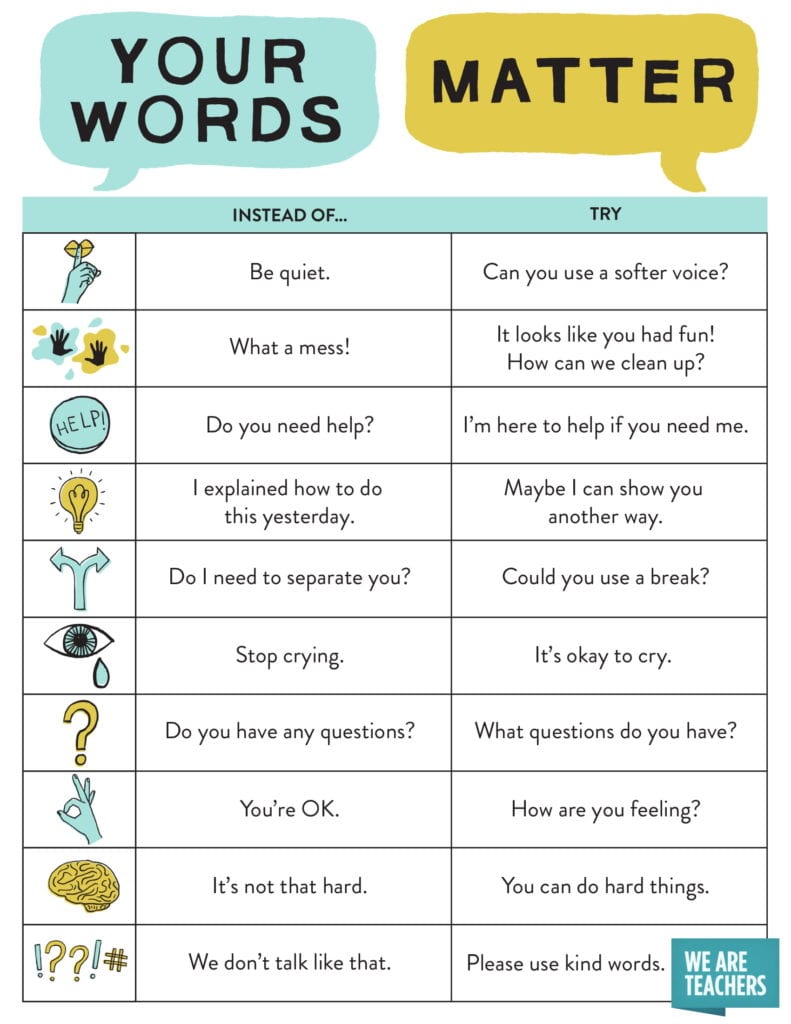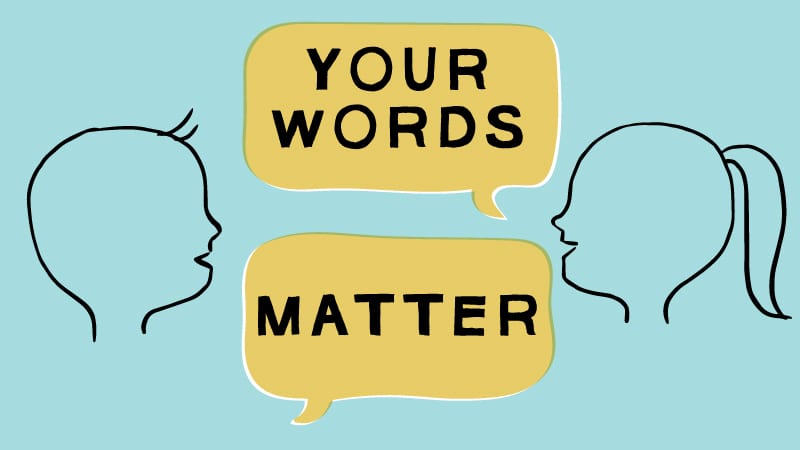As educators, we’re expected to be a lot of things to a lot of people. We’re teachers, coaches, caretakers, custodians, and so much more. To our students, we don’t just tell them what they need to learn, we show them in the way we, ourselves, behave.
In the middle of a chaotic classroom or other stressful situation, it can be hard to find the kind of mindfulness and positive language we hope to model. Here are a few ways we can do that with just some small adjustments to our words. Plus, get a FREE PDF of our Your Words Matter chart to share with your teachers or school.
Instead of “Be quiet.”
Try “Can you use a softer voice?”

School days are full of noise … so much noise! There are lots of creative ways to quiet down students. If you’re working with older kids, simply asking them to use a softer voice can do the trick. Often, when we’re excited, we may not even realize how loud we’ve really gotten. With younger children, try incorporating a familiar animal (“Show me what a sleeping cat looks like”). You can also add an element of friendly competition (“Who can be the quietest mouse?”) to help positively reach the desired noise level even faster.
Instead of “What a mess!”
Try “It looks like you had fun. How can we clean up?”

Anyone who works with kids knows that with great learning can come great messes. Art projects alone can leave your room looking scary, especially if you’re a teacher brave enough to use glitter. But be careful not to focus on the negative because it can quickly turn a happy, fun experience into a sad, disappointing one.
[contextly_auto_sidebar]
Instead of “You need to … “
Try “Together let’s … “
Life can be overwhelming. With so much going on, even the most simple, direct, and even heartfelt advice can be hard to process. Help a student stop, think, and focus on the absolute first thing they need to do to take a step in the right direction—and let them know they don’t have to do it alone. It may seem small, but it can actually be a huge help.
Instead of “Do you need help?”
Try, “I’m here to help if you need me.”

Educators are caretakers—some of the best there can be. We want to help, and offering it is second nature. However, we have to be careful how we do it. Using closed-ended questions, or not asking at all before we jump right in, takes away a student’s chance to work through challenges on their own. A gentle reminder that you’re there to help, on the other hand, reinforces your support for the student while giving them the room, and perhaps confidence, to explore the many possible ways they can reach success on their own.
Instead of “Let me do it.”
Try “I believe you can do it.”
It doesn’t matter what age you are or what situation you’re in: There are few things in life that feel better than hearing someone say they believe in you. Being the person who motivates and inspires children—especially when they need it most—can be as priceless to you as it is to them.
Instead of “I explained how to do this yesterday.”
Try “Maybe I can show you another way.”

It can be tough when, after trying so hard in so many ways, a student might not have grasped or retained a lesson. It could be for any number of reasons, so before we try reminding or repeating, perhaps take a moment to consider another approach altogether. This can be especially helpful at the beginning of building a relationship with a student, since you’re both learning how to communicate with each other most productively. Using a phrase like this, or even a version that uses an open-ended question, shows your student that you’re in this together!
Instead of “Do I need to separate you?”
Try “Could you use a break?”

When you just can’t handle the struggle of letting the on-again-off-again couple of the moment process another challenge on their own, it’s time to play moderator. This type of phrase articulates reminders, expectations, options, and choices in a way that makes everyone feel like they have a little more control of how things move forward.
Instead of “Stop crying.”
Try “It’s okay to cry.”

We’ve all had one: The kid who cries. All. The. Time. Some years you have a class full of them. If we let them, they take a huge amount of attention, and the rest of the class is left wondering and waiting. Luckily, we can still give care with this gentle and reassuring phrase, while returning focus to the lessons at hand for the whole class.
Instead of “Look at what you’ve done.”
Try “How can we fix this?”
Show and tell might get the class’s attention, but it’s not enough to get what you really want: a solution. Try asking a question like this instead to get the kids’ wheels turning about what needs to happen next. As they start brainstorming and thinking through options and processes, you may even find chances to practice social-emotional skills, like asking for help, offering assistance, and working together to achieve a common goal.
Instead of “Do you have any questions?”
Try “What questions do you have?”

Nothing stops a conversation before it starts like closed-ended questions. With just a tiny tweak in how we ask, we might just keep the door open in a way that students feel more comfortable walking through. The more they ask, the more engaged they become, and the more they learn!
Instead of “You’re OK.”
Try “How are you feeling?”

So many of us were told that we were OK, fine, or all right when we were kids. As adults, we often repeat this statement without much thought. However, if a child is crying, yelling, or giving us other signals that they are, in fact, not OK, we should probably believe them. Once we do, we can help them help themselves.
Instead of “It’s not that hard.”
Try “You can do hard things.”

Hearing something’s not that hard, or even that it’s actually pretty easy, can make that voice inside of our heads start spewing doubt left and right. Having someone acknowledge that something is hard AND that we can do it anyway? Now that’s a way to inspire trust and confidence.
Instead of “You need to listen.”
Try “I want to help you.”
Whether you’re one on one with a student or trying to herd a whole class, getting students to listen sometimes feels impossible. No matter the odds, letting them know that you are first and foremost there to help them can hopefully get (and keep) their attention, while continuing to build a stronger relationship.
Instead of “We don’t talk like that.”
Try “Please use kind words.”

The sad truth is that some of the environments kids are in outside of the classroom are places where they actually do hear plenty of “talk like that.” It’s not ideal, but shaming them about it isn’t either. Instead, try pointing them in a positive direction about expected behaviors by giving them a great example of being kind with a friendly reminder about using kind words.
Instead of “Calm down.”
Try “Breathe. I’m here to help.”
Rarely in the history of the world has telling someone to calm down resulted in anyone actually calming down! But if you can get them to take a moment to focus on slowing their breath, they will naturally begin to calm down. Doing it while reassuring them that support is all around? That can make it happen even faster and make the effect even stronger.

Love this chart and want to share it with your teachers or school? Get a FREE PDF of it right here.
Come and share your ideas for promoting positive language in ourWeAreTeachers HELPLINE group on Facebook.
Plus, get our free kindness posters.

